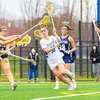Campus Projects, 2012
Not since the I.M. Pei-designed centerpiece of the “modern” campus (Maytum Hall, Daniel Reed Library, McEwen Hall and Michael C. Rockefeller Arts Center) took shape in the late 1960s has there been such a wide range of construction and design activity going on at once.
Campus officials broke ground last summer on the new, $60 million Science Center, the largest capital project in Fredonia’s history. When combined with the renovation of Houghton Hall, the complex will house all of the STEM disciplines (science, technology, engineering and math) and herald a new era in science education at Fredonia.
Also underway is a $10.3 million Williams Center renovation. The student union will soon be more user friendly by reconfiguring offices, meeting rooms and interior walls, upgrading technology and other amenities, and improving sight lines at entrances.
Spring will see the start of two other exciting projects: the $3 million Dods Hall Fitness Center and a $23 million townhouse-style residence complex. Meanwhile, design work continues for a projected $36 million Rockefeller Arts Center addition, envisioned to feature new classrooms, studio spaces and a welcome connection to neighboring Mason Hall, as collaboration among the performing arts programs grows ever stronger.
Science Center
The goal of this state-of-the-art facility is to improve the educational experiences of science majors and science education students and enhance student/faculty research. By placing chemistry, biology and other departments – currently taught in four separate buildings – in one facility, students will have the opportunity to work in a truly collaborative environment.
“Uniting all of the STEM disciplines is really, really important for the growth of all of our STEM programs,” said Dr. Holly Lawson, project shepherd. Her Herculean task is to represent future users of the building and insure that it’s built to facilitate learning, inspire students and faculty, and enable “intellectual collisions” between the different disciplines.
“The building has been carefully designed to provide flexible spaces that will support all types of learning,” Lawson added. “We also made a special effort to not hide the scientists or their science; the spaces will be as open as possible so that anyone walking by can view what’s going on inside. We want to put our science on display.”
Campus leaders were quick to recognize the expertise they could tap across the country to help design the facility. Twelve STEM alumni who have achieved great success formed a new Natural Sciences Advisory Council to provide valuable guidance and insight. They also gleaned ideas during tours of other university science buildings in five states.
The new, three-story structure, the initial planning for which began in 2006, will house chemistry, biology and science education classes, labs and offices, and also provide support for environmental science. At over 92,000 square feet, the building will be longer than a football field, though not quite as wide.
Among its impressive features are a 120-seat auditorium that will accommodate traditional and group learning activities; two “smart” classrooms suitable for all learning styles; an atrium featuring a café, displays and open seating; a roof-top observatory; an attached
greenhouse; and several student reading and conference rooms.
Faculty offices, situated in pairs, will be placed between teaching and research laboratories and also include informal teaching spaces composed of write-on glass walls and seating.
Its many architectural highlights include a science balcony with a vaulted roof and views into a courtyard that will contain native plants and local geologic features. Visitors will be able to view first-floor laboratories from corridors and windows from the courtyard.
The center was designed by Mitchell/Giurgola Architects, a New York City-based firm with a global reputation for excellence in the design of academic and scientific research facilities. Its portfolio includes projects at Cornell University, New York University and the University of Buffalo. Rochester, N.Y.-based Pike Company, the lead contractor, has built
facilities at Cornell and the University of Rochester, and also directed the recent renovation of Fredonia’s Nixon Hall.
Following its own renovation, Houghton will house the physics, geosciences, mathematical sciences, and computer and information sciences departments. The two buildings will be physically connected in a way that retains the I.M. Pei design that integrates support
columns into facades.
The unified facility will house 24 academic programs and boast slightly more than 180,000 square feet of space. Renovation of Houghton will commence after the Science Center is completed in January 2014.
Williams Center
The first and second floor interiors of this circular campus icon have been closed since last May so they can be updated and reconfigured to make the facility more appealing and inviting. New glass walls around the Multipurpose Room, combined with reviving the building’s signature skylights, will create an open atmosphere. Major entrances are being modified to improve accessibility and traffic flow inside the building; the loading dock is being reworked to create better sight lines that enhance pedestrian and vehicle safety.
The two dated, wooden-barrel-styled wall protrusions inside the Multipurpose Room are being replaced with balconies positioned to accommodate small musical ensembles. New windows will also be installed throughout the facility and recessed display cases placed in high-traffic areas.
Below-the-surface upgrades include new wiring, heating, ventilation and air conditioning systems, new audio/visual equipment in classrooms and conference areas, and an updated sprinkler system. The building will also have enhanced acoustics throughout.
The basement, which houses the Centre Point Food Court, Trendz Café and Horizon Room, was upgraded two years ago and has remained open during the renovation. In addition to the Multipurpose Room, the Williams Center also housed Financial Aid, Student Accounts, Lifelong Learning and Special Programs, the Student Association, Campus Life, the ticket office, The Leader, and the SUNY Fredonia Federal Credit Union, which have all been relocated.
Manning Squires Hennig Co., of Batavia, N.Y., is the general contractor for this project that’s included in the five-year capital plan launched in 2008. The first and second floors, which contain over 60,000 square feet, are expected to re-open this fall.
Dods Hall Fitness Center
Students can look forward to benefits of a state-of-the-art fitness center in the former pool area in Dods Hall. Its 7,000 square feet – more than double the size of the current fitness center – will offer new cardio and circuit machines, free weights, a modern sound system, lots of televisions and a designated stretching area. A 20-foot climbing wall will also be part of the air conditioned facility.
“It will be a very attractive space,” said Athletic Director Greg Prechtl. “The architect has done a great job opening up the east wall of the building and putting floor-to-ceiling windows so natural light comes in. The wood and earth tones make it a very attractive space. It’s going to be an overwhelming improvement over what we have.”
The current fitness center located in the basement of Dods – the site of a former bowling alley – is packed with aging exercise equipment.
“For a campus our size, it will be a first-class facility,” said Vice President for Student Affairs David Herman of the new planned amenity. Enrollment had yet to reach 2,000 students when Dods opened in 1963; today it is approximately 5,700.
“President Hefner has made terrific improvements to the physical plant of Fredonia State and in athletics, and students have been the beneficiaries of his vision,” added Prechtl. The Natatorium, University Stadium, and outdoor basketball and tennis courts were built, and
softball and baseball fields upgraded, during the Hefner era. “He and Dr. Herman have been very supportive of our athletic and recreational programs,” Prechtl said.
JCJ Architecture of Hartford, Conn., has designed the facility. Construction will start in May, with a January 2013 opening anticipated. “I think it’s really something we’ve needed for a long time. It will improve the quality of life for all students on campus,” Prechtl said. “Athletes are big users of the center, but its primary mission is to serve the general student population.”
Rockefeller Arts Center Addition
Projected at 40,000 square feet, this long-sought, two-story addition will be the fine arts center’s first expansion. The project, targeted to go out to bid in December, will accommodate relatively new programs that were not offered when the center opened 42 years ago, and also consolidate other curriculum offerings under one roof. For example, Dance and the Media Arts programs – now tucked away in Dods Hall and McEwen Hall, respectively – will be relocated to Rockefeller. Ceramics and sculpture studios will vacate their second floor space in favor of more practical first floor spaces.
“Every one of the spaces (studios, classrooms, computer labs and theatre support facilities) is operating at maximum capacity,” said Project Shepherd Stephen Rees. “No existing program can continue to grow in the current facility.”
According to Jefferson Westwood, the center’s longtime director, key features of the addition will include a multipurpose room to host an assortment of events, such as pre-concert lectures, post-performance discussions, film and video showings, and small receptions. It will also result in three new dance studios, including one with flexible, tiered seating that can double as a performance space; a new, attractive public entrance; and a café.
Several spaces “commandeered” from their original purpose, such as the Green Room that now doubles as storage and dressing rooms converted into offices, will return to their intended function, Westwood added.
A planned connector between Mason Hall and Rockefeller will enable performers and sensitive musical instruments to travel between the two buildings without being exposed to weather. Two new elevators for freight and passengers are also in the works.
The project, which advanced from the concept to design phase in 2011, is expected to reach the schematic phase (when walls will be placed and square-footage allotted) in January.
Rockefeller is a complex building with users who have diverse needs, said Rees, an emeritus professor of theatre and technical director. Meetings have been held with various user groups to determine their needs and how appropriate resources and facilities can be incorporated into floor plans.
“It’s exciting and a little bit frightening because you want to be able to solve existing problems and you have to anticipate that the solutions you come up with are going to have to last 50 years,” Rees said.
Some rehab work has been done over the years, and the art gallery was recently remodeled and named in honor of Cathy, ‘79, and Jesse Marion. “This addition far surpasses, by several orders of magnitude, all previous rehab jobs combined and is the first one to actually add to our total usable square footage of space,” added Westwood, who has supervised the center for the last 30 years.
Like the Science Center, this addition will honor the I.M. Pei design by continuing many architectural features found in Rockefeller and other campus buildings, Rees said. Construction is expected to start in the summer of 2013 and be completed by the fall of 2015.
Townhouses
Apartment-style living, a growing trend in collegiate housing, will make its SUNY Fredonia debut in August 2013 with the opening of the new townhouse village adjacent to Ring Road.
Nestled between the softball and baseball fields, this townhouse cluster will convey a neighborhood atmosphere with front porches, balconies, a separate community building, common green space, walkways and parking. There will be five different apartment layouts, each consisting of four single bedrooms, two baths, a fully-equipped kitchen and living/dining area. Buildings will range from one to three stories and contain a total
of 196 beds.
“It’s going to be another housing option for students,” explained Residence Life Director Gary Bice, “while also providing greater flexibility to accommodate upper-class students.” The townhouses will also enable SUNY Fredonia to expand its international student population that typically needs year-round accommodations.
On-campus housing will remain tight for another two years, Dr. Herman explained, until the townhouses are completed. They will represent the first new campus housing since University Commons opened in 2006. Construction is slated to begin this summer.
“We are very excited about these new construction projects, and we believe they will make a significant improvement in the quality of life on campus,” Herman said. “We only wish they could open this spring. Students are going to be very excited over the next two years as these new facilities become reality.”



